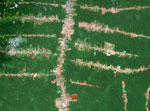As Peru’s legislature debates the merits of building the Purús highway through the Amazon rainforest, a new report by Global Witness alleges that the project has been aggressively pushed by those with a financial stake in opening up the remote area to logging and mining. Roads built in the Amazon lead to spikes in deforestation, mining, poaching and other extractive activities as remote areas become suddenly accessible. The road in question would cut through parts of the Peruvian Amazon rich in biodiversity and home to indigenous tribes who have chosen to live in “voluntary isolation.”
If built, the Purús highway would run 270 kilometers (167 miles) from Puerto Esperanza in Ucayali to Iñapari in Madre de Dios, bisecting Peru’s Alto National Park, the Purús Community Reserve and the Madre de Dios Territorial Reserve. According to the Global Witness report, the road would violate “Peru’s laws on protected areas.”
However, the road has a number of influential supporters, including an Italian priest in the region, Miguel Piovesan, who first proposed the road’s construction in 2004. Piovesan claims that those who oppose the road are denying economic development for local indigenous groups. In addition he says that isolated tribes do not exist in the area, despite evidence to the contrary from Peru’s National Park service.
But even the Global Witness report admits that the region is one of the most neglected in the country, likely due to a combination of remoteness and a very small population.

Aerial view of deforestation stemming from the controversial TransOceanic highway in the Peruvian Amazon. The major highway cuts through the rainforest in Brazil and Peru. Photo by: Rhett A. Butler.
“There is no doubt Purús needs development, according to the report. “73 percent of Purús homes do not have electricity and those which do only have access for five hours a day. A fifth of the population is illiterate, one of the highest rates in the country. There are only seven health posts and ten hospital beds in the whole province. Life expectancy and human development indicators are within the lowest 20 percent of all districts in Peru whilst per capita income is just US$85 a month.”
But Billy Kyte, campaigner with Global Witness, says that while no one disputes needs for development in parts of the region, the road is not the solution.
“It is crucial that investment comes to the isolated Purús region to improve services for the population, but there are important questions to be answered over who this project would actually benefit. The huge social and environmental costs that would result from this new highway have not been properly assessed and Congress should vote it down,” he notes. According to the report subsidized and increased airfare could play a major role in alleviating poverty in the region without the road.
The report alleges that the build-up to the road project reaching the legislature has been marred by conflict-of-interests, illegal contracts for timber, discrimination against indigenous people, and even bribery.
“A representative of the Federation of Native Communities of Purús Province (FECONAPU), the organization representing Purús’ indigenous
communities, was offered a bribe of 30,000 Soles (around US$10,000) by a local government official to support the road construction,” the report reads.
Global Witness also says that Purús municipality had already begun logging the proposed road area, even though the project has not been improved.
The NGO recommends that Peru’s congress immediately suspend the highway bill and investigate possible conflict-of-interests connected to the legislation.

Map of proposed highway. Image: Rocio Medina/La Republica. Image courtesy of Global Witness.
Related articles
Roads could help protect the environment rather than destroy it, argues Nature paper

(03/22/2013) Rapidly expanding road networks are causing large-scale damage to forests but proper infrastructure planning and implementation could actually turn them into a net positive for the environment, argue researchers writing in the journal Nature. William Laurance and Andrew Balmford highlight the severe environmental impacts of roads in wilderness areas, including fostering illegal logging, poaching, colonization, and land speculation.
Jaguars, tapirs, oh my!: Amazon explorer films shocking wildlife bonanza in threatened forest

(02/19/2013) Watching a new video by Amazon explorer, Paul Rosolie, one feels transported into a hidden world of stalking jaguars, heavyweight tapirs, and daylight-wandering giant armadillos. This is the Amazon as one imagines it as a child: still full of wild things. In just four weeks at a single colpa (or clay lick where mammals and birds gather) on the lower Las Piedras River, Rosolie and his team captured 30 Amazonian species on video, including seven imperiled species. However, the very spot Rosolie and his team filmed is under threat: the lower Las Piedras River is being infiltrated by loggers, miners, and farmers following the construction of the Trans-Amazon highway.
Amazon has nearly 100,000 km of roads
(12/08/2012) The Amazon Basin has 96,500 kilometers of roads, nearly two-thirds of which are unpaved, reports a comprehensive new atlas of the region, which contains the world’s largest rainforest.
Deforestation rate falls across Amazon rainforest countries

(12/06/2012) The average annual rate of deforestation across Amazon rainforest countries dropped sharply in the second half of the 2000s, reports a comprehensive new assessment of the region’s forest cover and drivers of deforestation. While the drop in deforestation in the Brazilian Amazon has been widely reported, several other Amazon countries saw their rates of forest loss drop as well, according to the report, which was published by a coalition of 11 Latin American civil society groups and research institutions that form the Amazonian Network of Georeferenced Socio-Environmental Information (RAISG).